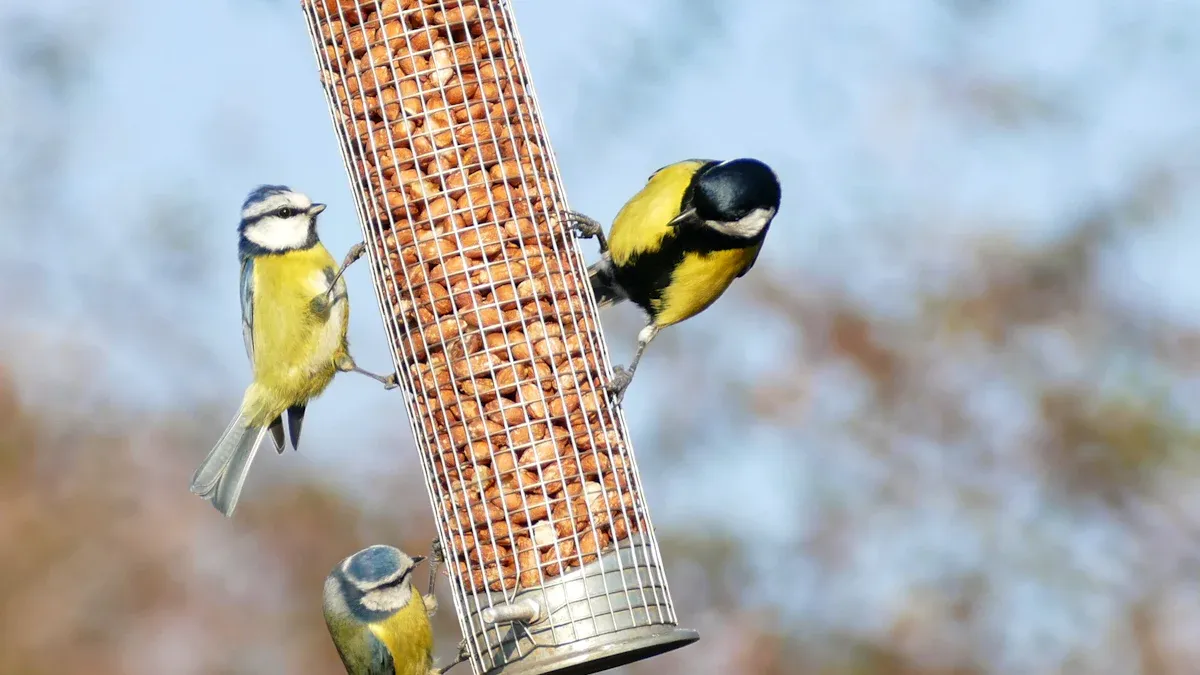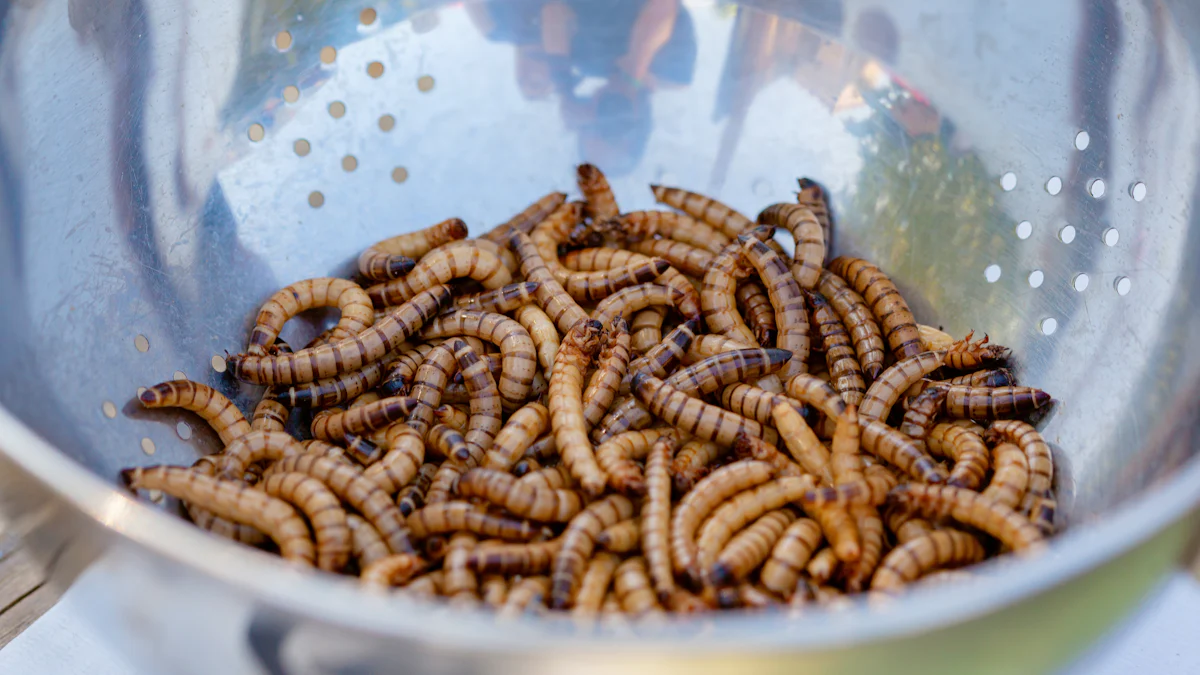
Have you ever wondered why mealworms are making waves in 2025? These tiny insects pack a punch when it comes to their nutritional value. They’re loaded with protein—up to 55% in powder form—and essential amino acids. Plus, they’re rich in healthy fats, fiber, and minerals like iron and zinc. Even better, mealworms are eco-friendly. They require minimal resources to farm and can even turn food waste into valuable protein. With their impressive mealworms nutritional value and sustainability, mealworms are reshaping how we think about food.
Key Takeaways
- Mealworms have a lot of protein, about 55%. This helps muscles grow and heal.
- They are good for the planet. They need less water and space than farm animals. They also make less pollution.
- Adding mealworms to meals is simple. Put them in smoothies, cookies, or salads for extra nutrition.
Mealworms Nutritional Value
Macronutrients: Protein, Fats, and Fiber
Mealworms are a nutritional powerhouse when it comes to macronutrients. They’re packed with protein—53% in dried form—which is more than double the protein content of beef. This makes them an excellent choice for building and repairing muscles. Plus, mealworms contain all essential amino acids, including lysine and leucine, which are vital for your body’s growth and recovery.
Their fat content is equally impressive, ranging from 25% to 35%. What’s great about mealworm fat is its healthy profile. It’s rich in omega-3 and omega-6 fatty acids, which support brain health and reduce inflammation. And let’s not forget fiber! Mealworms contain about 6% fiber, thanks to their chitin-rich exoskeleton. This helps improve digestion and keeps your gut happy.
Here’s a quick comparison:
| Nutrient | Dried Mealworms | Beef | Soybeans |
|---|---|---|---|
| Protein | 53% | 26% | 36% |
| Fat | 28% | 20% | 20% |
| Fiber | 6% | 0% | 9% |
Micronutrients: Vitamins and Minerals
Mealworms don’t just stop at macronutrients—they’re loaded with essential vitamins and minerals too. They’re a fantastic source of B vitamins like B12, niacin, and riboflavin, which help your body produce energy and maintain healthy skin. They also contain minerals like iron, zinc, magnesium, and phosphorus. These nutrients boost your immune system, strengthen your bones, and improve overall health.
Compared to other protein sources, mealworms stand out. For example, they have more iron than sirloin beef, making them a great option if you’re looking to prevent anemia. While they’re lower in calcium than dairy, their other nutrients more than make up for it.
Health Benefits for Humans and Animals
Adding mealworms to your diet can do wonders for your health. Their high protein content helps repair cells and supports muscle growth. The healthy fats improve heart health, while the fiber reduces cholesterol and keeps blood sugar levels stable. Mealworms also provide energy, thanks to their carbohydrates, and their vitamins and minerals enhance immunity and bone strength.
For animals, mealworms are just as beneficial. Chickens fed with mealworm-enriched feed lay eggs with brighter yolks and higher nutritional density. Pigs grow faster and produce leaner, tastier meat. Even fish love mealworms, showing increased feeding activity and better growth rates. This makes mealworms a win-win for both humans and animals.
Comparing Mealworms to Other Protein Sources
Mealworms vs. Meat-Based Proteins
When you compare mealworms to meat-based proteins like chicken or beef, you’ll notice some surprising differences. Mealworms contain 53% protein in their dried form, which is higher than beef and comparable to chicken. Here’s a quick look:
| Food Source | Protein Content (%) |
|---|---|
| Dried Mealworms | 53 |
| Chicken | Comparable |
| Beef | Less than mealworms |
But it’s not just about protein. Mealworms are packed with essential amino acids, fatty acids, and minerals like iron and zinc. In fact, they have more iron than sirloin beef! Plus, they’re much better for the planet. Producing 1 kg of mealworms uses less land and water and generates 300 times fewer greenhouse gas emissions compared to traditional livestock. That’s a win for your health and the environment.
Mealworms vs. Plant-Based Proteins
How do mealworms stack up against plant-based proteins like soy or lentils? They’re surprisingly similar in terms of nutrition. Mealworms offer all essential amino acids, just like soybeans, and they’re rich in B vitamins and minerals such as magnesium, phosphorus, and zinc.
Here’s the kicker: mealworms provide more protein per gram than most plant-based options. While soybeans are a great source of protein, mealworms also bring healthy fats and a unique crunch to the table. They’re a versatile option if you’re looking to diversify your protein sources.
Key Advantages of Mealworms
Mealworms shine when it comes to sustainability and nutrition. They require 13 times less water and 10% of the land needed for traditional livestock. Their feed-to-protein conversion ratio is also far superior, making them an efficient way to produce high-quality protein.
Here’s why you should consider mealworms:
- They’re packed with nutrients, including protein, essential amino acids, and fatty acids.
- They’re eco-friendly, producing far fewer greenhouse gases than meat.
- They can turn food waste into valuable protein, supporting a circular economy.
Mealworms aren’t just a food trend—they’re a sustainable solution for the future.
Mealworms in Sustainable Food Systems

Environmental Benefits of Mealworm Farming
Mealworm farming is a game-changer for the environment. Unlike traditional livestock, mealworms produce far fewer greenhouse gases. For example, they emit only 2-122 grams of greenhouse gases per kilogram of mass gain, compared to a staggering 2,850 grams from beef cattle. They also use much less water—just 4,341 cubic meters per ton, compared to beef’s 15,000 cubic meters.
Mealworms require significantly less land too. Producing one kilogram of edible protein from mealworms takes only 43% of the land needed for milk and a mere 10% of what beef requires. This efficiency helps reduce deforestation and habitat loss. Plus, mealworms can thrive on agricultural by-products, turning waste into valuable protein. Their farming has a smaller ecological footprint, making them a sustainable choice for the planet.
Addressing Global Food Security
Mealworms offer a practical solution to global food security challenges. They’re rich in protein, with 55% protein per serving, and contain all essential amino acids. They also have more iron than sirloin beef, making them a nutrient-dense option.
What’s more, mealworms can be farmed in small spaces, even in urban areas. This makes them ideal for local production, reducing the need for large-scale agriculture. In regions like Guatemala, where malnutrition is a serious issue, mealworm-based foods like banana pancakes have already improved children’s diets. By requiring less water and land, mealworms can help feed the growing global population sustainably.
Reducing Food Waste with Mealworms
Mealworms are nature’s recyclers. They thrive on organic waste, including food scraps and agricultural by-products. By converting waste into high-quality protein, they support a circular economy. Their excretions, known as frass, are rich in nutrients like nitrogen and potassium. Frass works as an excellent organic fertilizer, offering a sustainable alternative to chemical fertilizers.
In aquaculture, mealworms also shine. Fish love their taste and texture, leading to less feed waste. This makes mealworms a practical choice for reducing food waste while boosting sustainability in farming systems.
Practical Ways to Incorporate Mealworms
Mealworms in Human Diets: Tips and Recipes
You might be wondering how to add mealworms to your meals without it feeling too adventurous. Don’t worry—it’s easier than you think! Mealworms are incredibly versatile and can fit into many dishes you already enjoy.
For a quick snack, try dried mealworms seasoned with salt or garlic powder. They’re crunchy, flavorful, and packed with protein. Want a protein boost in your morning smoothie? Add a tablespoon of ground dried mealworms. You won’t even notice them, but your body will thank you.
If you love baking, mix ground mealworms into your muffin or cookie batter. It adds a nutty flavor and extra nutrients. Soups and stews are another great option. Rehydrate mealworms and toss them in to soak up the delicious broth. For something fresh, sprinkle dried mealworms on your salad for a satisfying crunch.
Looking for a full recipe? Try a Mealworm Lentil Salad. Combine 1 cup of cooked lentils, ½ cup of diced bell peppers, ¼ cup of chopped onions, ¼ cup of parsley, and ¼ cup of dried mealworms. Drizzle with olive oil and lemon juice, season with salt and pepper, and serve chilled. It’s simple, nutritious, and delicious!
Mealworms in Animal Feed: Benefits and Uses
Mealworms aren’t just great for you—they’re a game-changer for animal feed too. Farmers love them because they’re rich in protein (55% in powder form) and contain all essential amino acids. Chickens fed with mealworm-enriched diets lay eggs with brighter yolks and higher nutritional density. Pigs grow faster, producing leaner and tastier meat.
Mealworms also have excellent palatability. Animals find their unique shape and texture irresistible. In aquaculture, fish show high feeding activity when mealworms are included in their diet. This reduces feed waste and makes feeding more efficient.
Here’s why mealworms are a smart choice for animal feed:
- High Protein Content: Comparable to or better than soybean-based proteins.
- Healthy Fat Source: Rich in unsaturated fatty acids, which improve animal health.
- Sustainable Growth: Mealworms thrive on organic byproducts, requiring less water and land.
- Environmental Impact: Lower greenhouse gas emissions compared to traditional feed sources.
With the animal nutrition market projected to reach $1.27 billion by 2030, mealworms are set to play a major role in feeding the world’s growing animal population. Whether you’re raising chickens, pigs, or fish, mealworms can boost productivity and sustainability.
Mealworms are packed with nutrients and protein, making them a powerhouse for your diet. They’re also eco-friendly, requiring less water and land while emitting fewer greenhouse gases.
The UN’s FAO calls insects like mealworms a sustainable solution to feed the growing population.
Why not try mealworms? They’re nutritious, sustainable, and ready to revolutionize food systems!
FAQ
What do mealworms taste like?
Mealworms have a mild, nutty flavor. Some say they taste like roasted seeds or nuts. Their crunch makes them a fun addition to snacks or meals.
Are mealworms safe to eat?
Yes, mealworms are safe for humans and animals when farmed and prepared properly. Always buy from trusted sources to ensure quality and safety.
How do mealworms help the environment?
Mealworms require less water, land, and energy than traditional livestock. They also recycle food waste into protein, reducing environmental impact and supporting sustainable farming practices.


